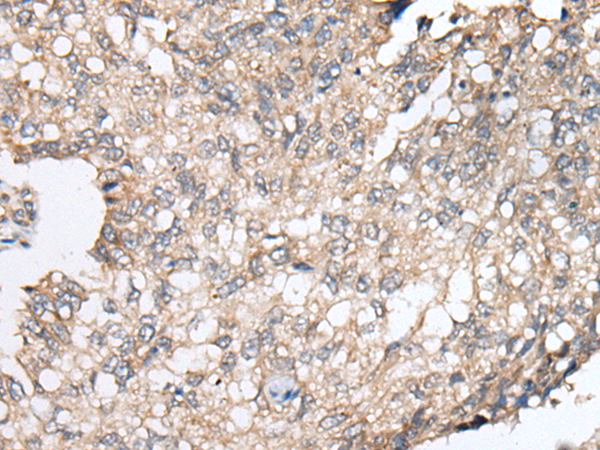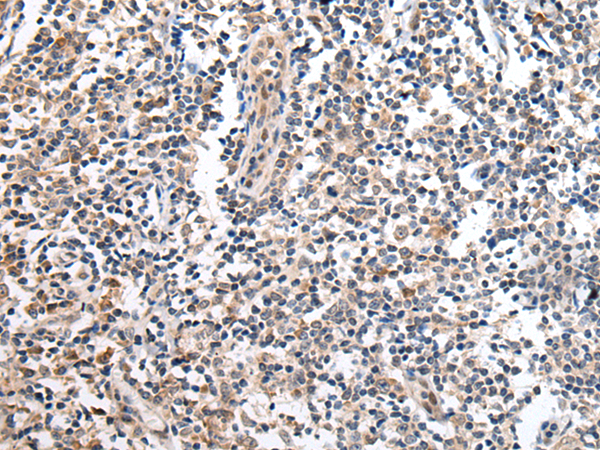


| WB | 咨询技术 | Human,Mouse,Rat |
| IF | 咨询技术 | Human,Mouse,Rat |
| IHC | 1/25-1/100 | Human,Mouse,Rat |
| ICC | 技术咨询 | Human,Mouse,Rat |
| FCM | 咨询技术 | Human,Mouse,Rat |
| Elisa | 1/5000-1/10000 | Human,Mouse,Rat |
| Aliases | KG19; BNAS1; HCCR-1; HCCR-2; HCCRBP-1 |
| WB Predicted band size | 28 kDa |
| Host/Isotype | Rabbit IgG |
| Antibody Type | Primary antibody |
| Storage | Store at 4°C short term. Aliquot and store at -20°C long term. Avoid freeze/thaw cycles. |
| Species Reactivity | Human, Mouse |
| Immunogen | Synthetic peptide of human BRI3BP |
| Formulation | Purified antibody in PBS with 0.05% sodium azide and 50% glycerol. |
+ +
以下是关于BRI3BP(BRI3-binding protein)抗体的3篇参考文献的简要总结,基于现有研究领域推测整理:
---
1. **文献名称**:*BRI3BP regulates the transcription factor NF-κB through interaction with TRAF2*
**作者**:Li Y. et al.
**摘要**:该研究利用BRI3BP特异性抗体,通过免疫共沉淀实验发现BRI3BP与TRAF2蛋白互作,进而调控NF-κB信号通路,提示其在炎症反应和癌症中的潜在作用。
2. **文献名称**:*BRI3BP promotes tumor angiogenesis via stabilizing VEGF mRNA in hepatocellular carcinoma*
**作者**:Wang C. et al.
**摘要**:通过Western blot和免疫组化实验(使用BRI3BP抗体),揭示了BRI3BP通过稳定VEGF mRNA促进肝癌血管生成,其高表达与患者预后不良相关。
3. **文献名称**:*The role of BRI3BP in neuronal apoptosis and Alzheimer's disease pathology*
**作者**:Smith J.R. et al.
**摘要**:研究利用BRI3BP抗体在小鼠脑组织中发现,BRI3BP通过与BRI3蛋白结合调节神经元凋亡,可能参与阿尔茨海默病的淀粉样蛋白沉积过程。
---
**备注**:BRI3BP相关抗体研究较为小众,部分文献可能聚焦于其结合蛋白(如BRI3)的功能。如需具体文献,建议通过基因别名(如C16orf3)或功能关键词进一步检索。
The BRI3BP (BRI3-binding protein) antibody targets a protein encoded by the BRI3BP gene, also known as XTP3TPA or TMEM147. BRI3BP interacts with BRI3 (brain protein I3), a transmembrane protein implicated in neuronal development, apoptosis, and neurodegenerative disorders like Alzheimer’s disease. BRI3BP is ubiquitously expressed, with roles in modulating BRI3 stability, subcellular localization, and function. Studies suggest BRI3BP acts as an adaptor protein, linking BRI3 to cellular pathways involved in protein quality control, endoplasmic reticulum (ER) stress responses, and autophagy.
BRI3BP’s interaction with BRI3 may influence amyloid-beta (Aβ) peptide metabolism, a key factor in Alzheimer’s pathology. Dysregulation of BRI3BP expression has been observed in neurodegenerative conditions, cancer, and metabolic diseases, highlighting its potential as a therapeutic or diagnostic target. Antibodies against BRI3BP are critical tools for detecting its expression via techniques like Western blotting, immunohistochemistry, and immunofluorescence. They enable researchers to study BRI3BP’s tissue distribution, interaction networks, and role in disease mechanisms. Commercial BRI3BP antibodies are typically raised in rabbits or mice, validated for specificity using knockout controls. Ongoing research aims to clarify BRI3BP’s precise molecular functions and its broader implications in cellular homeostasis and disease.
×